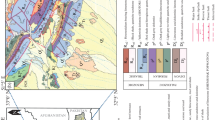Abstract
The problem of mantle metasomatism vs. crustal contamination in the genesis of arc magmas with different potassium contents has been investigated using new trace element and Sr–Nd–Pb isotopic data on the island of Vulcano, Aeolian arc. The analysed rocks range in age from 120 ka to the present day, and cover a compositional range from basalt to rhyolite of the high-K calc-alkaline (HKCA) to shoshonitic (SHO) and potassic (KS) series. Older Vulcano products (>30 ka) consist of HKCA–SHO rocks with SiO2=48–56%. They show lower contents of K2O, Rb and of several other incompatible trace element abundances and ratios than younger rocks with comparable degree of evolution. 87Sr/86Sr ranges from 0.70417 to 0.70504 and increases with decreasing MgO and compatible element contents. 206Pb/204Pb ratios display significant variations (19.31 to 19.76) and are positively correlated with MgO, 143Nd/144Nd (0.512532–0.512768), 207Pb/204Pb (15.66–15.71) and 208Pb/204Pb (39.21–39.49). Overall, geochemical and isotopic data suggest that the evolution of the older series was dominated by assimilation–fractional crystallisation (AFC) with an important role for continuous mixing with mafic liquids. Magmas erupted within the last 30 ka consist mostly of SHO and KS intermediate and acid rocks, with minor mafic products. Except for a few acid rocks, they display moderate isotopic variations (e.g. 87Sr/86Sr=0.70457–0.70484; 206Pb/204Pb=19.28–19.55, but 207Pb/204Pb=15.66–15.82), which suggest an evolution by fractional crystallisation, or in some cases by mixing, with little interaction with crustal material. The higher Sr isotopic ratios (87Sr/86Sr=0.70494–0.70587) of a few, low-volume, intermediate to acid rocks support differentiation by AFC at shallow depths for some magma batches. New radiogenic isotope data on the Aeolian islands of Alicudi and Stromboli, as well as new data for lamproites from central Italy, are also reported in order to discuss along-arc compositional variations and to evaluate the role of mantle metasomatism. Geochemical and petrological data demonstrate that the younger K-rich mafic magmas from Vulcano cannot be related to the older HKCA and SHO ones by intra-crustal evolutionary processes and point to a derivation from different mantle sources. The data from Alicudi and Stromboli suggest that, even though interaction between magma and wall rocks of the Calabrian basement during shallow level magma evolution was an important process locally, a similar interpretation can be extended to the entire Aeolian arc.
Similar content being viewed by others
Author information
Authors and Affiliations
Additional information
Received: 27 September 1999 / Accepted: 24 May 2000
Rights and permissions
About this article
Cite this article
De Astis, G., Peccerillo, A., Kempton, P. et al. Transition from calc-alkaline to potassium-rich magmatism in subduction environments: geochemical and Sr, Nd, Pb isotopic constraints from the island of Vulcano (Aeolian arc). Contrib Mineral Petrol 139, 684–703 (2000). https://doi.org/10.1007/s004100000172
Issue Date:
DOI: https://doi.org/10.1007/s004100000172




